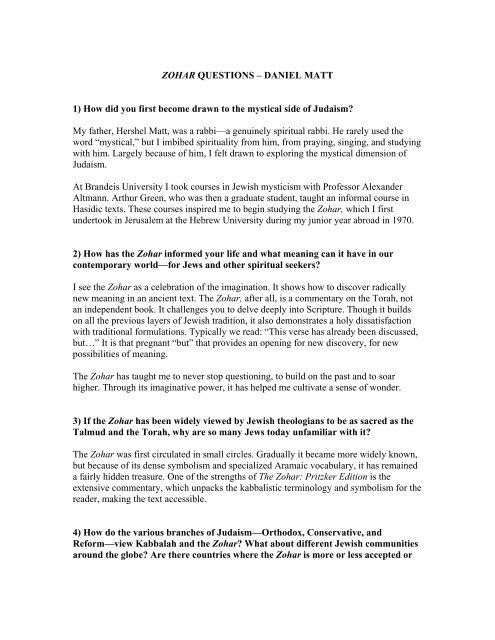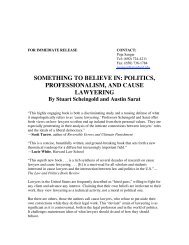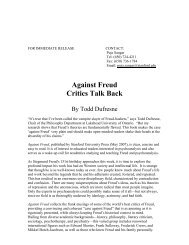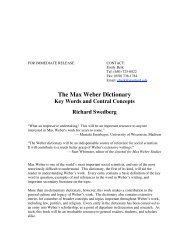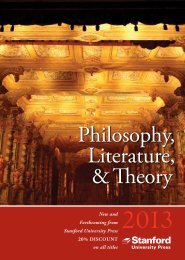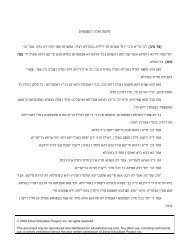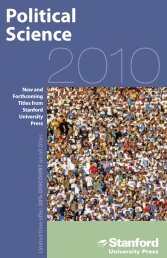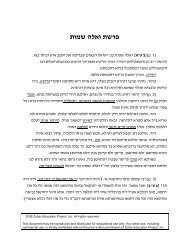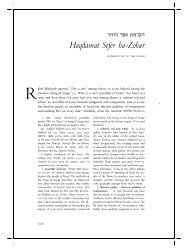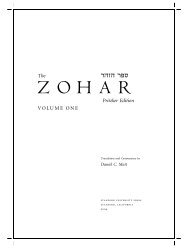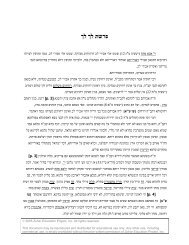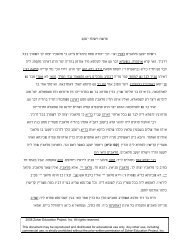Questions and Answers (PDF)
Questions and Answers (PDF)
Questions and Answers (PDF)
You also want an ePaper? Increase the reach of your titles
YUMPU automatically turns print PDFs into web optimized ePapers that Google loves.
ZOHAR QUESTIONS – DANIEL MATT<br />
1) How did you first become drawn to the mystical side of Judaism?<br />
My father, Hershel Matt, was a rabbi—a genuinely spiritual rabbi. He rarely used the<br />
word “mystical,” but I imbibed spirituality from him, from praying, singing, <strong>and</strong> studying<br />
with him. Largely because of him, I felt drawn to exploring the mystical dimension of<br />
Judaism.<br />
At Br<strong>and</strong>eis University I took courses in Jewish mysticism with Professor Alex<strong>and</strong>er<br />
Altmann. Arthur Green, who was then a graduate student, taught an informal course in<br />
Hasidic texts. These courses inspired me to begin studying the Zohar, which I first<br />
undertook in Jerusalem at the Hebrew University during my junior year abroad in 1970.<br />
2) How has the Zohar informed your life <strong>and</strong> what meaning can it have in our<br />
contemporary world—for Jews <strong>and</strong> other spiritual seekers?<br />
I see the Zohar as a celebration of the imagination. It shows how to discover radically<br />
new meaning in an ancient text. The Zohar, after all, is a commentary on the Torah, not<br />
an independent book. It challenges you to delve deeply into Scripture. Though it builds<br />
on all the previous layers of Jewish tradition, it also demonstrates a holy dissatisfaction<br />
with traditional formulations. Typically we read: “This verse has already been discussed,<br />
but…” It is that pregnant “but” that provides an opening for new discovery, for new<br />
possibilities of meaning.<br />
The Zohar has taught me to never stop questioning, to build on the past <strong>and</strong> to soar<br />
higher. Through its imaginative power, it has helped me cultivate a sense of wonder.<br />
3) If the Zohar has been widely viewed by Jewish theologians to be as sacred as the<br />
Talmud <strong>and</strong> the Torah, why are so many Jews today unfamiliar with it?<br />
The Zohar was first circulated in small circles. Gradually it became more widely known,<br />
but because of its dense symbolism <strong>and</strong> specialized Aramaic vocabulary, it has remained<br />
a fairly hidden treasure. One of the strengths of The Zohar: Pritzker Edition is the<br />
extensive commentary, which unpacks the kabbalistic terminology <strong>and</strong> symbolism for the<br />
reader, making the text accessible.<br />
4) How do the various branches of Judaism—Orthodox, Conservative, <strong>and</strong><br />
Reform—view Kabbalah <strong>and</strong> the Zohar? What about different Jewish communities<br />
around the globe? Are there countries where the Zohar is more or less accepted or
popular? How have attitudes toward the mystical side of Judaism changed over the<br />
centuries? What is the connection between contemporary Hasidism <strong>and</strong> the Zohar?<br />
It is difficult to generalize about how the various branches of Judaism view Kabbalah <strong>and</strong><br />
the Zohar. Within each denomination there are rabbis <strong>and</strong> laypeople who are more<br />
inclined or less inclined toward mysticism. Generally, one could say that many ultra-<br />
Orthodox Jews adhere to mystical Judaism. Over the past 10-15 years, many Reform<br />
Jews have felt attracted to certain aspects of Kabbalah, seeking to deepen their<br />
spirituality.<br />
Kabbalah crystallized in Spain, <strong>and</strong> the Zohar first appeared there; so both Kabbalah <strong>and</strong><br />
the Zohar have been revered throughout the Sephardic world. In contemporary Israel,<br />
Kabbalah <strong>and</strong> the Zohar are especially popular among Sephardic <strong>and</strong> Mizrahi (Eastern)<br />
Jews, but also among many young, secular Israelis who hunger for spirituality.<br />
Mystical Judaism gained in popularity after the revival in Safed late in the 16 th century.<br />
After the debacle of the Sabbatean messianic movement, there was a reaction against<br />
mysticism, or at least against its public consumption. Hasidism can be seen as a<br />
popularization of Kabbalah, spreading mystical teachings once again to the masses, while<br />
neutralizing certain messianic aspects.<br />
5) How did you become involved in this Zohar translation project?<br />
In September 1995 my friend Arthur Green called me <strong>and</strong> told me about a woman from<br />
Chicago named Margot Pritzker. She had been studying the Zohar with an Orthodox<br />
rabbi, Yehiel Poupko, but the dated English translation they were reading had proved<br />
inadequate. Margot had decided to commission a new translation, said Art, <strong>and</strong> she was<br />
inviting me to undertake the task.<br />
I was astounded, <strong>and</strong> told Art that I needed a few days to consider this. The days turned<br />
into weeks, which turned into months, as I kept wrestling with the thrilling, terrifying<br />
offer. I decided to translate a short section of the Zohar to see how it felt, but I poured<br />
myself into the experiment so intensely, day after day, that I was left drained, exhausted,<br />
discouraged. How could I keep this up for years <strong>and</strong> years? I reluctantly resolved to<br />
decline the offer, but Art convinced me to at least meet this woman <strong>and</strong> her rabbi, so the<br />
following May the four of us gathered at the O’Hare Hyatt. I expressed my hesitation to<br />
them, <strong>and</strong> told Margot that the project could take twelve-to-fifteen years—to which she<br />
responded, “You’re not scaring me!” I was won over by her genuine desire to penetrate<br />
the Zohar <strong>and</strong> make it accessible to English readers.<br />
6) At what point in the project did you decide that you would have to first construct<br />
a critical Aramaic text? In deciding which variant to choose, did you always opt for<br />
the older one? What other considerations came into play?
I began translating from the st<strong>and</strong>ard printed edition of the Zohar, figuring that I would<br />
check variant readings in the manuscripts when I came across difficult readings or<br />
multiple readings in the printed text. Gradually I discovered that in numerous other<br />
instances the manuscript variants offered superior readings; so I decided to work with the<br />
manuscripts more systematically.<br />
Deciding which variant to use is a constant challenge. Sometimes I see that a number of<br />
the older, more reliable manuscripts offer what seems to be a “better” reading: more in<br />
line with the Zohar’s unique theology, style, syntax, or vocabulary. For example, later<br />
copyists, editors or printers have often “corrected” apparent mistakes in the<br />
manuscripts—“mistakes” that are actually typical Zoharic formulations. These I restore.<br />
Often, as well, later h<strong>and</strong>s have added explanatory words or phrases. Based on<br />
manuscript evidence, I often delete these, thereby restoring some of the original mystery<br />
to the text. In my commentary I offer clarification.<br />
7) How do the different interpretations of the Zohar that have arisen in different<br />
times reflect the societies from which they emanated?<br />
The Zohar is such a powerful work of imagination that whoever studies it can’t help but<br />
imagining its message in new ways. Every commentary on the Zohar reflects the<br />
mentality of the commentator.<br />
The most significant development in Zoharic commentary was the Lurianic revolution. In<br />
the 16 th century, Issac Luria immersed himself in the Zohar. His underst<strong>and</strong>ing of the text<br />
generated a new formulation of Kabbalah, which became dominant. All Kabbalists today<br />
are, in effect, Lurianic Kabbalists, <strong>and</strong> they read the Zohar through the lens of Lurianic<br />
Kabbalah.<br />
In my commentary I have attempted to go back before Luria, to scrape away several<br />
hundred years of Lurianic readings <strong>and</strong> recover something closer to “what the Zohar<br />
meant” when it first emerged. This, of course, is impossible; you cannot recapture the<br />
mentality of a 13 th -century kabbalist or totally escape a 21 st -century mindset. But still, I<br />
have tried to approach what one of my teachers used to call peshat ha-Zohar, its “simple<br />
sense.”<br />
8) The Pritzker edition is the first annotated English translation by a recognized<br />
academic authority, but have there been scholarly translations with commentary<br />
into other languages? How did any of these editions—in Hebrew, French, German,<br />
or other languages—influence your English translation?<br />
I have consulted the excellent French translation by Charles Mopsik, which so far<br />
consists of seven volumes. He achieves a fine balance between accuracy <strong>and</strong> fluidity.<br />
I have consulted a number of fine Hebrew translations, including those of Yehudah<br />
Ashlag (the Sullam), Yechiel Bar-Lev (Yedid Nefesh), Yehudah Edri, Daniel Frisch
(Matoq mi-Devash), <strong>and</strong> Isaish Tisbhy’s masterful anthology, Mishnat ha-Zohar (also<br />
available in an English translation by David Goldstein: The Wisdom of the Zohar).<br />
Hebrew renderings of the Zohar are extremely helpful because the author(s) of the Zohar<br />
was often thinking in Hebrew while composing in Aramaic.<br />
Although the old English translation by Sperling, Simon, <strong>and</strong> Levertoff is inadequate, it<br />
was nevertheless helpful. When its paraphrases didn’t capture the original Aramaic, they<br />
provided their own kind of commentary.<br />
A translator needs all the help he can muster, <strong>and</strong> I am grateful for the efforts of all my<br />
predecessors.<br />
9) What are the special challenges of translating a work whose meaning is often<br />
cryptic <strong>and</strong> elusive?<br />
If much of the Zohar’s power <strong>and</strong> fascination lies in its language—its “unusual,<br />
striking wording” <strong>and</strong> “unruly, untamed vibrancy”—how does the translator<br />
convey this in a language whose structure <strong>and</strong> flavor are very different from the<br />
original?<br />
Is the Zohar purposefully cryptic or has its meaning become more <strong>and</strong> more obscure<br />
the further removed we are from the time when Aramaic was a living language?<br />
What indications are there in the text that let us know that the Zohar was “not<br />
intended to be easily understood, but rather to be deciphered”?<br />
What did you mean when you wrote that “in exploring the Zohar linguistic search<br />
<strong>and</strong> spiritual search go h<strong>and</strong> in h<strong>and</strong>”?<br />
The Zohar is notoriously obscure—perhaps the most difficult Jewish classic to translate.<br />
It was composed in 13 th -century Spain mostly in Aramaic, a language no longer spoken<br />
there. The author(s) concocted a unique blend of Aramaic out of traditional sources. This<br />
unparalleled neo-Aramaic is peppered with enigmatic expressions, puns, outl<strong>and</strong>ish<br />
constructions, puzzling neologisms, grammatical mistakes, <strong>and</strong> traces of medieval<br />
Hebrew <strong>and</strong> Castilian.<br />
The Zohar’s prose is poetic, overflowing with multiple connotations, composed in such a<br />
way that you often cannot pin down the precise meaning of a phrase. The language<br />
matches the subject matter, which itself is mysterious, elusive, <strong>and</strong> ineffable; words can<br />
merely suggest <strong>and</strong> hint. An unfathomable process may be stated, then immediately<br />
denied: “It split <strong>and</strong> did not split its aura.” Sometimes we encounter oxymorons, such as<br />
“new-ancient words,” alluding to the dual nature of the Zohar’s secrets: recently<br />
composed yet ascribed to ancient sources. The first impulse of divine emanation is<br />
described as botsina de-qardinuta, “a spark of impenetrable darkness,” so intensely<br />
bright that it cannot be seen.
Especially puzzling, though charming, are the neologisms strewn throughout the Zohar,<br />
intended to bewilder <strong>and</strong> astound the reader. Some derive from rare Talmudic terms,<br />
which the author refashions by intentionally misspelling or by inverting letters; some<br />
derive from Greek, Latin, or Castilian; some appear to be pure inventions.<br />
One newly-coined noun, tiqla, is particularly versatile. In various contexts it can mean<br />
“scale, hollow of the h<strong>and</strong>, fist, potter’s wheel, <strong>and</strong> water clock.” This last sense refers to<br />
a device described in ancient <strong>and</strong> medieval scientific literature, which in the Zohar<br />
functions as an alarm clock, calibrated to wake kabbalists precisely at midnight for the<br />
ritual study of Torah. A similar device was employed in Christian monasteries to rouse<br />
monks for their vigils. How appropriate to invent a word for an invention!<br />
Often, by pondering the context, comparing Zoharic <strong>and</strong> rabbinic parallels, <strong>and</strong> scouring<br />
sundry dictionaries <strong>and</strong> lexicons, one can decipher or at least conjecture the meaning of<br />
these weird terms, but some remain as perplexing as originally intended.<br />
Despite its difficulties, the potency of the Zohar’s language has mesmerized countless<br />
readers, even those who could not plumb its secrets. While kabbalists delved deeply, the<br />
uninitiated chanted the lyrical Aramaic, often unaware of its literal meaning. In the words<br />
of an eighteenth-century mystic, “Even if one does not underst<strong>and</strong>, the language is suited<br />
to the soul.”<br />
I am aware of the risks of translating the Zohar, but it would be worse to leave these<br />
gems of wisdom buried in their ancient Aramaic vault. So I have plunged in, seeking to<br />
transmit some of the Zohar’s magic. Though I wish to make the Zohar accessible, I also<br />
want to convey its strangeness, potency, <strong>and</strong> rich ambiguity. Here the commentary is<br />
essential. When the translation cannot adequately express a multifaceted phrase, I unfold<br />
the range of meaning in the commentary. When the translation is as cryptic as the original<br />
Aramaic, the commentary rescues the str<strong>and</strong>ed reader.<br />
My style of translation is literal yet poetic. I am convinced that a literal rendering of the<br />
Zohar is not only the most accurate but also the most colorful <strong>and</strong> zestful—the best way<br />
to transmit the lyrical energy of the Aramaic. Still, at times, the multivalent language<br />
invites a certain freedom of expression. Let me cite one example (Zohar 1:83a), where<br />
Rabbi Shim’on describes the nighttime journey of the soul, soaring skyward from her<br />
sleeping body: “Flying, she encounters those qumrin tehirin of defilement.”<br />
What does this bizarre term mean? The Sperling-Simon translation renders it as “certain<br />
bright but unclean essences.” The English translation of Tishby’s Wisdom of the Zohar<br />
reads: “the deceiving lights of uncleanness,” while Tishby’s original Hebrew translation<br />
reads a bit differently: qimmurei negohot—roughly: “vaulted splendors”—though in his<br />
note he acknowledges that the meaning is “doubtful.” I render the sentence as follows:<br />
“Flying, she encounters those hooded, hunchbacked, dazzling demons of defilement.”<br />
The accompanying commentary explains that these are malevolent forces who block the<br />
ascent of an unworthy soul. Qumrin derives via rabbinic usage from the Greek qamara,
“arched cover,” while tehirin is a cognate of the Aramaic tihara, meaning “brightness,<br />
noon.” One class of demons is named tiharei, “noonday demons.”<br />
Although the Zohar’s basic vocabulary is limited, its roots generate a rich variety of<br />
meanings, which dem<strong>and</strong> a wide range of English renderings. For example, the root tqn<br />
spans the following: “establish, institute, mend, restore, correct, perfect, prepare, arrange,<br />
array, adorn.” The root slq can mean: “rise, raise, culminate, attain, surpass, depart,<br />
disappear, die, remove, postpone, reserve, emit (fragrance).”<br />
I find that I have to navigate between conflicting meanings <strong>and</strong> determine the appropriate<br />
one—or sometimes to discover how differing meanings pertain simultaneously. The<br />
frequent dilemmas of interpretation suggest that in exploring the Zohar, linguistic search<br />
<strong>and</strong> spiritual search go h<strong>and</strong> in h<strong>and</strong>. By this I mean that you can’t just read the text; you<br />
have to contemplate possible meanings. You have to enter openings created by the rich<br />
language, travel down the winding paths, try out various potential implications, see how<br />
they resonate within yourself. In this quest, the intellect is vital, but so is the spirit; the<br />
two must work h<strong>and</strong>-in-h<strong>and</strong>, aiding <strong>and</strong> correcting one another. The Zohar cannot be<br />
fully appreciated on a purely academic level; it dem<strong>and</strong>s engaging the text <strong>and</strong> selfreflection.<br />
10) Is it possible for the curious reader with little previous knowledge of Kabbalah<br />
or the Zohar to simply pick up this translation <strong>and</strong> read it with comprehension?<br />
What background knowledge is needed to guide the reader through the esoteric<br />
language <strong>and</strong> symbolism <strong>and</strong> ambiguity of the Zohar?<br />
I have composed this translation for the intelligent lay reader. In other words, someone<br />
who has little previous knowledge of Kabbalah should be able to approach the book. The<br />
Translator’s Introduction discusses my method <strong>and</strong> suggests “How to Read the Zohar.” A<br />
separate, extensive introduction by Arthur Green discusses the development of the<br />
Kabbalah <strong>and</strong> the symbol system of the Zohar. These two introductions should prepare<br />
you.<br />
However, the Zohar was never intended to be easy reading. It is meant to be pondered,<br />
not immediately grasped. My commentary (printed at the bottom of the page) clarifies the<br />
symbolism <strong>and</strong> the unique terminology, though I here have tried not to be heavyh<strong>and</strong>ed—not<br />
to ruin the subtlety <strong>and</strong> ambiguity of the original. I want to allow <strong>and</strong><br />
compel you to wrestle with the text.<br />
11) What is the significance of the Zohar’s erotic imagery? What is the union of<br />
male <strong>and</strong> female used to depict? How is the concept of “exile” used in the Zohar?<br />
One of the secrets of the Zohar’s success was surely its bold eroticism, which appears in<br />
both the divine <strong>and</strong> human realms. Here God is equally male <strong>and</strong> female, <strong>and</strong> the human<br />
task is to promote the “sacred union” of the divine couple: the Holy One, blessed be He,
<strong>and</strong> His divine bride, Shekhinah. Human sexuality is also central; in fact, through the<br />
unification of a human couple below, the divine partners are also united.<br />
Exile affects not only the people of Israel but God as well. According to the Zohar, God<br />
shares in the people’s exile, w<strong>and</strong>ering along with them, comforting them. Eventually,<br />
God will actually be redeemed along with Israel, a process that depends vitally on human<br />
righteousness <strong>and</strong> ethical behavior.<br />
12) What has it been like for you to commit to a project as immense as this Zohar<br />
translation—one that will take many years to complete? How have the dem<strong>and</strong>s of<br />
this project changed your life—professionally <strong>and</strong> personally? What was it like<br />
working in Jerusalem during the first part of this project? Did your family<br />
accompany you?<br />
When the project was first proposed, I realized that it would change my life. I have never<br />
worked so hard—or been so fulfilled. I have basically restructured my life around the<br />
project. I work as much as I can each day, without exhausting or draining myself. I eat<br />
very carefully <strong>and</strong> exercise daily. I feared at the beginning that I might grow tired of the<br />
work, but now, after six years, I love it even more than when I began.<br />
I avoid any other professional commitments <strong>and</strong> limit my socializing. The time I spend<br />
with my family is precious to me.<br />
I spent the years 1998-2002 in Jerusalem with my wife <strong>and</strong> two children. For the first two<br />
years, I worked at the Institute for Advanced Studies at the Hebrew University. The next<br />
two years I spent at the Shalom Hartman Institute. Both of these provided superb<br />
environments for my research <strong>and</strong> writing. Despite the tension in Jerusalem, our entire<br />
family treasures the time we spent there.<br />
13) How has your work on this project enriched your own underst<strong>and</strong>ing of the<br />
Zohar? What are some of your favorite passages of the first two volumes of the<br />
Zohar?<br />
I began studying the Zohar in 1970. I later composed an anthology of Zohar translations<br />
that was published in 1983 (Zohar: The Book of Enlightenment). But now, after working<br />
intensively on this project for the past six years, I feel a much deeper intimacy with the<br />
book, like I’m inside of the text. The stimulation is endless: it’s as if I’m navigating<br />
rapids, surrounded by stunning scenery, flirting with danger, constantly encountering<br />
challenges <strong>and</strong> surprises, learning from each failure <strong>and</strong> success. There is nothing I’d<br />
rather be doing.<br />
My favorite passages include the following:
1) The concluding verse in the biblical story of the Garden of Eden reads: He drove out<br />
Adam (Genesis 3:24; literally, He drove out the human). In the Zohar, Rabbi El’azar<br />
remarks: “We do not know who divorced whom: if the blessed Holy One divorced Adam,<br />
or not.”<br />
As the rabbi demonstrates, the mystical meaning is the shocking alternative lurking<br />
within that bl<strong>and</strong> phrase, “or not”: Adam drove out, divorced Shekhinah (the divine<br />
feminine), splitting Her from Her divine partner <strong>and</strong> from himself. Once, as Adam,<br />
humanity was wedded to God. The original sin lies in losing intimacy with the divine,<br />
thereby constricting our unbounded awareness. This loss is inevitable—a consequence of<br />
tasting the fruit of knowledge, the price we pay for maturity <strong>and</strong> culture. But the spiritual<br />
challenge is to search for that lost treasure—without renouncing the self or the world.<br />
2) The Zohar’s interpretations often seem far removed from the literal sense. But<br />
sometimes a verse is read “hyperliterally,” ignoring idiomatic usage in favor of a<br />
radically spiritual sense. For example, in Genesis 12, God comm<strong>and</strong>s Abraham, Lekh<br />
lekha, two Hebrew words that are often translated: “Go forth” (to the l<strong>and</strong> that I will<br />
show you). Rabbi El’azar insists on reading the words more literally than they were<br />
intended: Lekh lekha: “Go to yourself!” Search deep within to discover your true self.


